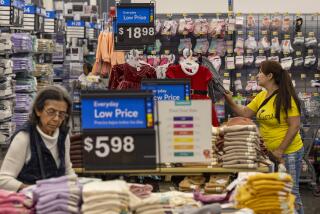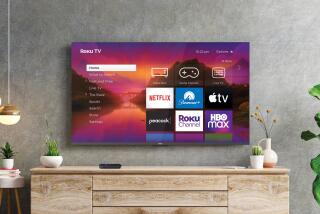Focusing on the big picture gives Vizio edge in TV market
- Share via
William Wang likes being disruptive, and television shoppers are paying the price -- a lower price.
In 2002, when plasma TVs were selling for $10,000, the Taiwanese-born entrepreneur set out to sell one for $2,999. He fulfilled his ambition a year later, shipping a 46-inch model with a $2,799 price tag, about half what other brands then charged.
Now his Irvine-based company, Vizio Inc., is the No. 1 maker of flat-panel TVs in North America, outselling entrenched Asian competitors in the second quarter. The private company says that it is profitable, that it recorded nearly $700 million in revenue in 2006 and that it is on track for $2 billion in sales this year.
“They supplanted all the heavy hitters, including Sony and Samsung,” said Edward Taylor, an analyst with the DisplaySearch research firm. “That’s an incredible accomplishment.”
Wang used a recipe similar to the one that catapulted Dell Inc. to the top of the personal computer heap two decades ago. Vizio sells TVs for temptingly low prices by slashing expenses, minimizing inventory, bypassing traditional retailers and aggressively managing suppliers.
Perhaps the biggest boost along the way came from Costco Wholesale Corp., which in 2004 gave the tiny manufacturer instant access to millions of generally higher-income shoppers.
“They are the most aggressive and fastest-growing TV maker in the market,” said Van Baker, an analyst for research group Gartner Inc. “They operate on razor-thin margins and they keep overhead to a minimum. They have very low inventory and they turn their inventory over very fast. They’re what Dell used to be.”
A graduate of USC’s electrical engineering program, Wang, 43, cut his teeth in the computer display business with Santa Ana-based Mag Innovision Inc., selling monitors that giant computer makers such as Gateway Inc. bought and resold under their own brand names.
But he had bigger ambitions. With his Asian manufacturer contacts, Wang believed that he could assemble a high-end plasma TV at a fraction of the standard price.
He took his idea to Gateway founder Ted Waitt, who was then the company’s chief executive. Waitt was just embarking on a new strategy: selling higher-margin consumer electronics in an effort to bring the struggling company back to profitability. He hired Wang, and in December 2002 Gateway shipped its first television.
Gateway eventually bailed out of consumer electronics to focus on PCs. Wang decided to do it himself.
Vizio’s first TV, the “V,” was nearly half the price of competitors’. But the TV had technical flaws and earned mediocre reviews. He sold only about 2,000.
“We learned we had to improve the quality and make it even more affordable,” Wang said.
He ironed out the bugs and started buying only top-quality screens from the same manufacturers that supply top-tier brands. The tweaks have paid off with better reviews.
Wang keeps expenses lean. The company employs just 90 people -- more than half of whom in customer support.
Chief Technical Officer Ken Lowe does double duty writing the company’s product manuals. Wang, who once aspired to be an architect, helps design the TVs and their remote controls.
Compared to its competitors, Vizio spends little on marketing and advertising but splurges on packaging, with full-color boxes that catch shoppers’ eyes as they walk past.
“It was exactly the right thing to do,” said Costco executive Bill Prescott, who buys consumer electronics for the stores. “They created a splendid presentation that stood out compared to the other plain brown boxes.”
Said Vizio’s Lowe: “Our boxes are our salesmen.”
In just a few short years, Vizio has become Costco’s bestselling TV brand.
“It’s just been a wave of success that we’ve been riding on for three years now,” Prescott said. “They’ve done everything right.”
With the price of electronics components constantly falling, Vizio buys only what it needs, keeping costly inventory below a 30-day supply. The industry averages around 45 days, according to research firm Gartner. Vizio doesn’t want to pay $3 for a microchip only to have its price drop to $2.90 before the company can assemble the TV.
For Laynie Allen Newsome, Vizio’s vice president of sales, that sometimes means forgoing short-term sales bursts and saying no to retailers that request more TVs than Vizio estimates the stores will sell.
“We tell our retail partners that how they perform today determines the inventory they get next week,” Newsome said. “Our retailers are always caught off guard when we tell them that.”
Wang sells his TVs through discount retailers, such as Costco and Wal-Mart Stores Inc., that have modest markups, skipping traditional retailers that generate profits by selling products for as much as 30% more than they paid wholesale.
“Vizio’s key advantage is lower price,” said Riddhi Patel, an analyst with market research firm iSuppli Corp. in El Segundo.
The average price of a Vizio 32-inch liquid-crystal display TV in the second quarter was $609, compared with $1,245 for Sharp, $1,181 for Sony and $1,078 for Samsung, according to iSuppli.
That’s what persuaded Jolex Del Pilar to buy a Vizio set from Costco in September.
“If I had money to throw around, I’d buy the Sony,” the 26-year-old programmer from Anaheim said. “But being price-conscious, I thought the Vizio offered the best quality for the money.”
That type of thinking, along with a dose of good luck, helped Vizio capture 11.9% of the market for flat-panel TVs in North America during the second quarter, the highest of any brand, according to DisplaySearch. Samsung came in second with 11.3%, followed by Sharp with 7.9%.
Although the research firm hasn’t tabulated the third-quarter numbers, analysts don’t think Vizio will maintain its No. 1 position, largely because Wal-Mart stocked up on Vizio sets during the quarter while other manufacturers were whittling down inventory to make way for newer models. Still, the company’s growth is ramping up the competitive heat in the industry.
“Samsung spent an incredible amount of money and effort in gaining the No. 1 spot,” DisplaySearch’s Taylor said. “All of a sudden, this little start-up comes along and takes away that hard-won, multi-decade effort.”
Now, Vizio’s biggest challenge is to maintain its momentum by convincing consumers it’s not just another cheap fly-by-night operation. Because the company’s products have been out for just four years, no one knows how well they will perform in the long haul.
“They don’t have a track record like Sony,” Taylor said. “They need to somehow become a trusted brand in the eyes of consumers.”
--
Vizio Inc.
Product: High-definition plasma and liquid-crystal display TVs
Headquarters: Irvine
CEO: William Wang, 43
Founded: 2002
Revenue in 2006: Nearly $700 million
Estimated 2007 revenue:
$2 billion
Employees: 90
Source: The company






